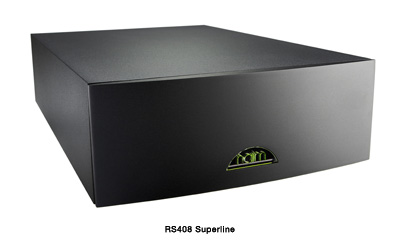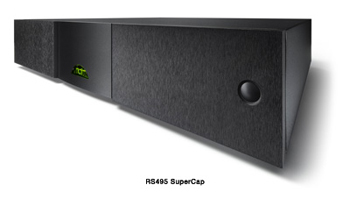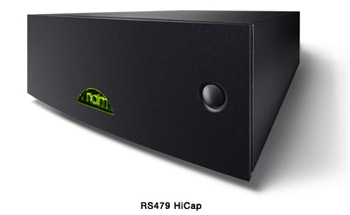| Naim SuperLine Reference Phono Stage - Likely the best phono stage for vinyl lovers |
 by
Chris Chamberlin by
Chris Chamberlin
At the outset, let me clearly state that I am a proponent of
tube audio as opposed to solid-state audio gear. Having exposed
my subjective preference in terms of music presentation, I
can unabashedly continue with the following phono stage review.
By way of a little background, I have been an audio enthusiast
for the past 35 years. I have a fairly large collection of
both records and CDs, which cover a number of musical genres.
The journey to try to achieve audio bliss has been an exercise
in trial and error, but also, for the most part, a great deal
of fun, with the occasional hiccup along the way. Recently
my audio friend David McCallum approached me to inquire if
I'd be interested in doing some writing for the high-end Inner
Ear audio webzine. David and I both share the love of audio
and also have similar tastes in two channel stereo equipment.
Before I agreed to the assignment, I asked David specifically
which piece he wanted me to audition and write about. He responded
with two very appealing choices, one of which was the Naim
SuperLine phono stage.
About Naim
Naim is a British manufacturer of high quality audio electronics. Founded in
1973, Naim has designed and manufactured a long list of highly respected amplifiers,
speakers and digital components, competing successfully with other electronics
manufacturers. The SuperLine phono stage is a part of their series of Reference
audio components.
Before we begin to discuss the listening experience, let’s
briefly examine and chat about the two boxes that comprise the SuperLine phono
stage. The device itself only accommodates moving coil cartridges, which are
generally the choice of discriminating audiophiles today. The main internal board
where the external inputs (both RCA and B&C) are mounted is freely suspended
on six springs, which are said to eliminate micro phonic disturbances. This suspension
system is by way of a brass sub-chassis and being particularly heavy eliminates
the influence of the wiring loom on the free movement of the sub chassis.
 Now
we move to the power supply choices, which are the foundation for all of Naim’s
Reference series components. However, with options available from Naim, choosing
the right power supply will be an educated decision, based on listening preferences
or on personal budgetary constraints. Naim provides three power supply options
for the SuperLine phono amp. Basic power can be fed by a FlatCap power supply.
Larger and audibly superior is the HighCap, and at the pinnacle of vinyl bliss
is the incredibly revealing SuperCap power supply. Alternatively, power can be
derived from the Aux 2 input of most of Naim’s preamplifiers helping one
get started without the need of an external supply which can be added when funds
allow. Prices range from $1595.00 for the FlatCap to $7395.00 for the SuperCap.
The HighCap falls somewhere in between. Now
we move to the power supply choices, which are the foundation for all of Naim’s
Reference series components. However, with options available from Naim, choosing
the right power supply will be an educated decision, based on listening preferences
or on personal budgetary constraints. Naim provides three power supply options
for the SuperLine phono amp. Basic power can be fed by a FlatCap power supply.
Larger and audibly superior is the HighCap, and at the pinnacle of vinyl bliss
is the incredibly revealing SuperCap power supply. Alternatively, power can be
derived from the Aux 2 input of most of Naim’s preamplifiers helping one
get started without the need of an external supply which can be added when funds
allow. Prices range from $1595.00 for the FlatCap to $7395.00 for the SuperCap.
The HighCap falls somewhere in between.
For the audition Naim provided both the
HighCap and SuperCap power supplies. From a performance point of view, the HighCap
proved itself to be a very worthy unit, and when paired with the SuperLine phono
keeps the unit in a surprisingly affordable price point. However the full capabilities
of the SuperLine are not fully realized until you pair it with the SuperCap.
It was in this combination that the majority of the listening tests occurred.
Technology
Below are some details provided to me by Steve Sells, the designer of the
SuperLine phono amp. The first stage in the phono amp has a flat response,
and is designed for low noise (82dB awtd ref 500uV). The passive stage performs
the high frequency part of the RIAA eq. This uses selected metal film resistors
and polypropylene capacitors. The second stage is similar to the first stage,
but biased differently as the signal is now larger. This stage performs the
remaining parts of the RIAA EQ, again using selected components and a single
end Class-A output stage. The brass weight is 3kg and with six springs forms
a sub sonic suspension system. We feel this is great for sound and quite expensive
to build, but worth it! The unit is hand wired to allow the suspension to work
and gives great low impedance PSU connections. It has 25 internal zero feedback
ultra-low noise power supplies. These can be powered from the SuperCap, where
it uses all the supplies for maximum benefit. They have a very low time constant;
this is why it takes two minutes to un-mute when it is turned on. It takes
a few days of operation and isn’t fully burned in until about three weeks.
After this time, all capacitors have formed and their leakage is minimized.
Finally, the SuperLine has externally adjustable loading for both — capacitance
and resistance. The unit comes with plugs with various ratings (10kΩ,
1k, 500Ω, 220Ω, 100Ω, 100pF, 1nF, 5.6nF, 10nF) that can be
configured in different combinations by the user. Also, a pair of transit bolts
resides under the unit, and should be removed prior to use (although no damage
will occur if the bolts are left in place). The bolts secure the main board
of the SuperLine and — once removed — the internal components ‘float’ on
the previously mentioned springs giving the listener the benefit of the innovative
isolation that the brass sub chassis provides.
 The
Specs: Cartridge compatibility: 100mV to 500mV; Gain: 64dB; Input load
options: 10k Ohms (no plug), 1k Ohm, 500 Ohms, 220 Ohms, 100 Ohms (resistive),
100pF (no plug), 1nF, 5.6nF, 10nF (capacitive). Max output: 7.5V RMS. Inputs:
One BNC, one RCA The
Specs: Cartridge compatibility: 100mV to 500mV; Gain: 64dB; Input load
options: 10k Ohms (no plug), 1k Ohm, 500 Ohms, 220 Ohms, 100 Ohms (resistive),
100pF (no plug), 1nF, 5.6nF, 10nF (capacitive). Max output: 7.5V RMS. Inputs:
One BNC, one RCA
Outputs: Naim SNAIC (w/HiCap2), Naim Burndy (w/SuperCap2)
Into The
Music And Sound
Getting down to serious listening would take a few days of break-in, so after
David kindly hooked up the SuperLine to my Allnic T2000 Integrated amplifier,
I inserted my trusty Granite Audio phono break-in disk into my EAR Acute Mkii
CD player, and left it in repeat mode for a series of long days. After the
fifth day, and overcome with unbridled curiosity, I finally sat down in my
listening chair for an inaugural audition. First up on the platter of my Technics
SP10 Mkii with Graham Phantom 2.2 arm and Miyabi 47 cartridge was my original
copy of Steely Dan's 1981 album Gaucho. "Babylon Sisters", track
one from side two, is a song familiar to many audiophiles, but is one I’m
still trying to sort out. Using the same arm and cartridge, I’ve found
that on some phono stages the vocal can sound recessed and veiled. The Superline,
however, renders Donald Fagan’s voice as neutral (uncoloured) and in
the foreground of the recording. I suspect this was how it was intended to
sound in the mix. The bass line is taut and articulate. There is a sense of
ease and effortless flow to the music. Second up and another of my must-test
tracks is Roberta Flack’s The First Time I Saw Your Face on Roberta Flack’s
Greatest Hits. Again, the bass sounded natural and uncoloured, while Roberta’s
vocal was rich, warm and enveloping. What the SuperLine presented beautifully
was the cymbals in the left channel, which are generally inaudible. Also, with
many of the top-line stages I have used, the bass can easily sound either too
taut or flabby; the Superline, however, gets it spot on. The SuperLine is by
no means polite. Cranking up Elvis Costello’s Watching the Detectives
from the album My Aim is True gives all the grunt and searing grit this song
evokes. The vocals have richness where you feel the vocalist right in front
of you. Percussion, such as wood blocks or castanets, has an uncanny sense
of realism. Because I like all kinds of music, it's often hard to find pristine,
perfect pressings of rare old favourites. I snatched up an old copy of the
Best of the Beau Brummels and the SuperLine made that classic sound good; no,
it made it sound great! I use Tannoy Canterbury loudspeakers within a combination
of three tube-based power amplifiers and two tube-based preamplifiers. The
Canterburys are known to be quite revealing, and I find them to be one of the
best speakers at reproducing the human voice. Whether its solo presentations
or large choral works, the combination of the Naim SuperLine at the front end
and the Canterburys at the tail end produces truly breathtaking music. I can’t
stop reaching for more records to play. This phono stage is really that good.
Closing Thoughts
The trick to getting the most out of a dedicated phono stage is finding the
best settings for a particular cartridge. This isn’t always easy and
cartridge specs don’t always guarantee a perfect cartridge-to-phono match.
It's best to experiment with the loading and gain adjustments and judge for
yourself. My wife’s hearing is better than mine and her sense of perfectly
balanced sound is excellent. Between the two of us, we experiment until we
are satisfied that all is tonally right coming from the transducers. For me,
the phono stage hunt has been a long one, but I can safely say, without reservation,
that this is the finest sounding phono preamp I’ve ever had in my system,
regardless of price. Quality of workmanship, logical layout and most of all
sound performance are my criteria, and that is because I’m totally blind
and visual aesthetics don’t influence my take on a product. I have a
dedicated listening room, so the WAF factor doesn’t enter into the equation
either. I admit to suffering from a certain degree of obsessive-compulsive
disorder so painstaking care is taken in placement of all components including
speakers and cables. This also helps in my orientation to the system. I opened
this essay by stating that I prefer tube equipment to solid-state gear. I’m
doing an about-face, since that isn’t the case anymore. The Naim SuperLine
phono stage with the SuperCap power supply is the number one phono preamp on
my long list of top high-end phono-stage I have lived with. The engineers at
Naim have something special here.
|
| MODELS |
MANUFACTURER |
| Naim SuperLine Reference Phono Stage; Hicap-2 & Supercap
Power supplies |
Naim Audio |
| RATING |
CONTACT |
Over The Top (Chris'
scale)
|
Plurison
http://plurison.com/
|
| PRICE |
$ $3,995.00 (SuperLine);
$2,395.00 (Hicap);
$7,395.00 ( Supercap)
|
| Dimensions |
| |
|
|
